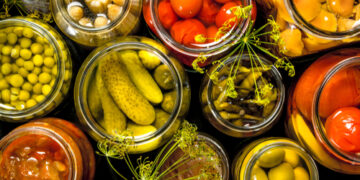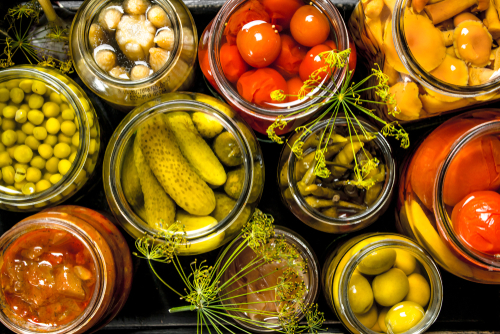Where Abundance Meets Intention
As the last tomatoes ripen on the vine and crates of apples, peppers, and squash pile high at the farm stand, there’s a quiet urgency in the air. The garden is still generous, but the nights are cooling, and the season begins to fold in on itself. Growing up, this was the time when our kitchen turned into a workshop of jars and steam, of boiling pots and cloth-covered counters. Preserving was never just about food—it was about holding onto the warmth of summer and fall, tucking it into glass and freezer bags to be unwrapped when the world turned cold and quiet.
A Generational Practice Rooted in the Land
Long before refrigeration, preservation was a matter of survival. Root cellars brimmed with stored squash and apples, and rows of canned tomatoes lined the pantry like stained-glass windows. Every family had its own rituals: grandma’s sweet pickles, dad’s frozen corn, that one plum jam recipe passed down like an heirloom. These weren’t just recipes—they were acts of reverence for the harvest. Each jar and pouch was a small triumph, a way to stretch the bounty and feed your people through the leaner months ahead.
Canning: Bottling Up the Sun
Canning is both science and art—an alchemy of heat, acid, and time that transforms perishable produce into shelf-stable treasures. If you’ve never done it before, start simple and follow tested recipes for safety.
Canned Tomato Sauce (Water Bath Method)
Yields about 4 quarts
Ingredients:
-
12 lbs ripe tomatoes
-
½ cup bottled lemon juice (or 2 tbsp per quart jar)
-
2 tsp salt (optional)
-
Fresh basil leaves (optional)
Instructions:
-
Bring a large pot of water to a boil. Score tomatoes and blanch for 30–60 seconds. Transfer to ice water and peel.
-
Chop and simmer tomatoes for 30–40 minutes until thickened.
-
Sterilize jars. Add lemon juice and salt to each jar.
-
Fill jars with hot sauce, leaving ½-inch headspace. Add basil if using.
-
Wipe rims, seal with lids, and process in a boiling water bath for 40 minutes.
-
Let cool undisturbed. Check seals before storing in a cool, dark place.
Pickling: A Tangy Celebration of Crunch
Pickling is fast, satisfying, and endlessly versatile. It requires no special equipment—just vinegar, salt, sugar, and seasonal produce.
Quick Refrigerator Pickles (No Canning Required)
Makes 2 pint jars
Ingredients:
-
2 cups thinly sliced cucumbers or vegetables of choice
-
1 cup water
-
1 cup white vinegar
-
1 tbsp salt
-
1 tbsp sugar
-
2 cloves garlic, sliced
-
1 tsp mustard seeds or dill seeds (optional)
Instructions:
-
Pack vegetables into clean jars with garlic and spices.
-
In a saucepan, heat water, vinegar, salt, and sugar until dissolved.
-
Pour hot brine over vegetables.
-
Let cool, then refrigerate. Ready in 24 hours, keeps for up to a month.
Freezing: A Pause Button for Peak Ripeness
Freezing lets you preserve flavor and nutrition with minimal prep. It’s especially handy for berries, corn, beans, and herbs.
How to Freeze Summer Corn
-
Shuck and rinse corn. Blanch ears in boiling water for 4 minutes.
-
Cool in ice water, then cut kernels off the cob.
-
Spread kernels on a baking sheet and freeze until firm.
-
Transfer to freezer-safe bags, label, and use within 6–9 months.
Herb Freezing Tip:
Chop herbs like basil or parsley and freeze them in olive oil using an ice cube tray. Once frozen, pop cubes into soups, sauces, or stews all winter long.
Ad Banner #1
— Placeholder for your first ad —
Why Preserving Matters
By putting up the harvest, we reduce food waste, stretch our budgets, and support a seasonal way of eating that respects the land’s timing. You get more from each tomato, each zucchini, each apple—because you’ve honored it with your time and care. Preserving also creates food security, a stocked pantry that reflects not just convenience but resilience. It’s the kind of cooking that slows you down and reminds you what the seasons taste like.
Respecting the Land and the Labor
Whether you’re growing your own or buying from local farms, preservation deepens your relationship to the food and the people who brought it forth. Use every part when you can—freeze peels for broth, pickle stems, compost scraps. Choose blemished produce that might otherwise be wasted. And preserve in small batches, as your time allows. This isn’t about perfection—it’s about intention.
Tucking Sunshine into Jars
There’s a quiet satisfaction in opening a jar of tomato sauce in February and remembering the heat of August. Or pulling frozen blueberries from the freezer and stirring them into pancake batter as snow falls outside. These moments are why we preserve. They’re reminders that the land gave generously—and that we listened.
Make the Most of the Moment
Set aside a Saturday. Spread out your kitchen towels. Invite a friend. Boil the kettle, prep your vegetables, and begin. Whether it’s one jar or a pantry full, preserving the harvest is a way of saying thank you—to the season, to the soil, and to yourself.
Ad Banner #2
— Placeholder for your second ad —



























